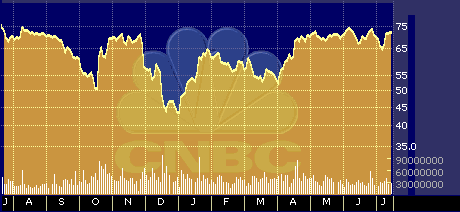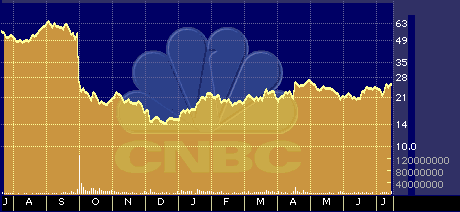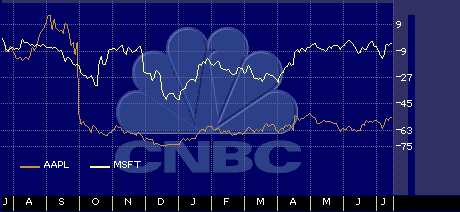
Third-Party Software, International Sales To Determine Apple’s Future
Third-Party Software, International Sales To Determine Apple’s Future
by Hal Plotkin
Silicon Valley Correspondent
CNBC.com
Jul 21 1999 6:06AM ET
Steve Jobs’ expected rollout of Apple Computer’s new laptop may capture investors attention but two other items will determine the company’s long-term prospects.
There are encouraging signs in both those areas — with some important caveats.
The first key issue involves the number and quality of third-party software designed to work with Apple {AAPL} products. “There is renewed interest by third-party vendors,” confirms Tim Bajarin, an industry consultant who heads Creative Strategies Research International in Campbell, Calif.
Back when Apple was in the trough, companies were reluctant to make products for the market-share-losing platform. That situation began to turn around, ironically, when Microsoft {MSFT} founder Bill Gates announced a broad product and technology development agreement with Apple at the 1997 Boston MacWorld gathering.

MSFT 52-week price chart
More recently, several major vendors have joined Microsoft in supporting Apple with new software.
Canon {CANNY}, a leading Japanese maker of computer printers, has announced an agreement with Infowave, based in Vancouver, Canada, to collaborate on the creation of software to link Apple computers to Canon’s popular multifunction (print, fax, copy, and scan) printers.
Meanwhile, companies such as REAL Software, Inc., based in Austin, Texas, and RecoSoft Corporation, based in Osaka, Japan, are touting new improved Apple-compatible software that helps users create state-of-the-art Web sites, a critical growth market.
One problem, however, is emerging: worrisome reports that third-party vendors are, so far, not making much money in the newly-revived Apple market.
According to Creative Strategies’ Bajarin, only 30 percent of iMac buyers purchase additional software, a figure that is far lower than for comparable Windows-based systems.
In essence, Apple’s failure in this regard is linked to the company’s success in building an easy-to-use product that appeals to first-time buyers. Many of those customers, it appears, are not interested in doing much more than word processing or surfing the web, which are easy to do with software that comes bundled with the iMac.
“The question is whether Apple’s customer base will entice more companies to make compatible software,” Bajarin says.

AAPL 52-week price chart
For investors, there is an easy Warren Buffet-style way to measure Apple’s progress. All you have to do is take a walk through your local computer store and count how many aisles are devoted to Apple-compatible products.
The other key area that will determine Apple’s prospects involves international sales. Unit volume in the worldwide PC market is expected to grow 21.3 percent this year, according to International Data Corporation (IDC).
Apple needs to capture a growing share of the international market to survive in the long-term. Without strong international sales, third-party vendors will have even less incentive to produce software for the Apple platform.
Fortunately for Apple, the company is moving up fast in international markets. Taken together, sales outside the U.S. accounted for fully 45 percent of Apple’s third quarter revenues.
According to figures released by the company, Apple’s sales increased by 42 percent in Europe, the Middle East, and Africa, 33 percent in the Asia/Pacific region (excluding Japan), and 98 percent in Japan during the third quarter of this year, as compared with last year.

Comparison Chart: AAPL, CANNY, MSFT 52-week performance chart
However, currency conversion rates make Apple products relatively more expensive in some parts of Europe, such as England, which could undermine the company’s continued growth if, as expected, prices for Windows-based PCs continue to fall.
Right now, most of the hoopla surrounding Apple focuses on the innovative industrial designs, epitomized by the iMac, created by Steve Jobs and his talented marketing team.
But novel industrial designs are fleeting in nature. It’s only a matter of time before Wintel vendors begin selling similar, eye-catching Windows-based products.
Tim Bajarin estimates Apple’s lead in the industrial design area will last no more than about eighteen months. “After that,” Bajarin says, “the company still has to convince me it will be around for the long-term.”
And that will be determined not so much by the popularity of Apple’s new laptop, but by how many Apple-compatible software products you find on the shelves of your local computer store and how well the company does selling into non-U.S. markets. While there is room for some cautious optimism, the jury is still out on those far more critical issues.


